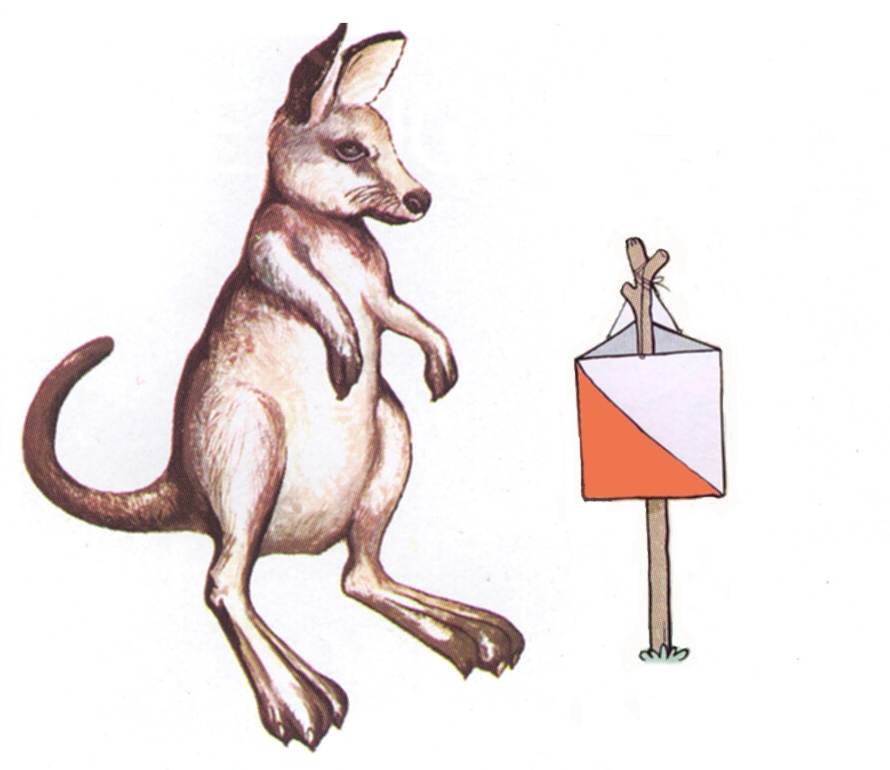
Red Kangaroo Orienteers
Orienteering was introduced to the Australian public with an event at Upper Beaconsfield, Victoria, in August 1969. Amongst the competitors at this first event were Ray White, Mike Hubbert and George Claxton – well-known Red Kangaroo Orienteers in later years. Co-organiser was Tom Andrews who persuaded Peter Wills-Cooke to assist in setting this first course. Peter never became an active orienteer, preferring to stay with track & field.
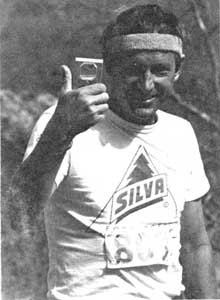
Photo: Tom Andrews – thumbs up for SILVA
A few months later at Elliott Lodge, near Healesville, the Novice course was won by Tom Andrews in 1hr 23min 40sec and the Open course by Mike Hubbert in 3hrs 51min 25sec (only Mike and Tony Kerr of MUMC beat 4 hours!).
Originally the club was known as the Richmond Harriers Orienteering Club and members were closely involved in the establishment of Orienteering in Victoria, the VOA, and ultimately the OFA.
As the club began to attract new members solely interested in Orienteering the decision was made in May 1972 to change the name to the Red Kangaroo Orienteers. Members of the Red Kangaroos were prominent in the administration of the sport from the outset. John Lewis was President of the VOA for some years. Tom Andrews took on the promotion and education role in the OFA from its formation and Mike Hubbert was Treasurer of the VOA before becoming Secretary of the OFA for six years.
World Championships
It was in May 1976 that two Red Kangaroos hatched the plot to apply to host the 1985 World Orienteering Championships in Australia. The year 1985 was chosen because it was the most distant year for which the IOF had requested applications. With much lobbying of IOF member countries it is now history that Australia was awarded the WOC’85 event at the 1980 IOF Congress, attended by the same two Red Kangaroos as members of the Australian delegation of three. Tom Andrews went on to become Chairman of the IOF Development and Promotion Committee.
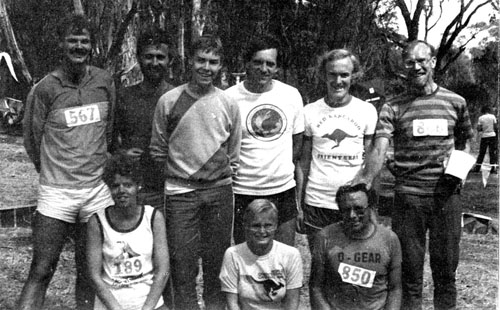
Photo: Some RKs pose for the camera in 1986.
Back: Dave Knight, Greg Tamblyn, Peter Andrews, Jon Buckeridge, Mike Hubbert, John Edwards.
Front: Vivienne French, Carol Smyth, Louie the Fly (“Mr Lewis to you”).
First Colour map
The first full-colour Orienteering map in Australia was introduced by the Red Kangaroos in March 1973 at an event at Egerton. Now, after many revisions, the map is known as Blackfellows Flat. That first coloured map was printed on untearable waterproof paper. The innovation so incensed another club that, at their event two weeks later, they offered a map “specially printed on environmentally friendly dissolving paper”.
Slaty Creek quickly followed for the 1973 Victorian Championships and that area became the venue for the 1985 Victorian Championships as part of WOCARN.
The club introduced computers to the sport at the 1975 Australian Championships conducted at Mt. Tallarook. Wayne Fitzsimmons of Data General provided the hardware. The area is now known at Mt. Hickey.
The overseas influence
Red Kangaroos were amongst the earliest Australian competitors in the established European Orienteering events and were quick to show our European friends that there was thunder down under. Mike Hubbert was the first Australian to regularly compete on the UK Orienteering circuit and to venture beyond the Arctic Circle to run under the midnight sun in Norway’s Midnatsol Galoppen. Tales of the exploits of Louie The Fly (or Jean Louis) at Swedish Five-Day events are still related throughout O-Ringen circles.
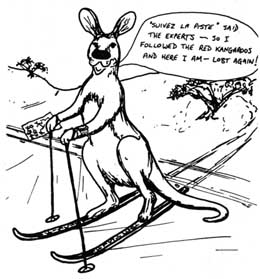
Cartoon by John Walker
Pub-O
To the press, Orienteering was a novelty sport in the early days and RKs capitalised on this with a number of promotional stunts including charity runs. One was Orienbeering and John Lewis claims that he and John Hilton are still Australian Orienbeering Champions having downed 13 coldies in 12 hotels over a 5km course in 59min. They share the title with a lamp-post which happened to get in the way. The extra drink was a navigational mistake and the bartender is still wondering about the clues he was asked to hand over.
Pub-O continued for some years in small towns like Ballan and Little River, usually on a Saturday night when Larry Sykes was setting courses the following day. Larry was an amateur magician, which explains some of his courses.
The Grog King at Easter events was another RK innovation. The rules were very simple – anyone who beat Louie was disqualified. Funnily enough, Louie never won the title, but Keith Pryor did one year and his winnings were well appreciated.
The last control
The RK post-event social always attracted visitors, particularly at cold events in winter. Graham Davies was chief pyromaniac for many years and his huge fires were the envy of other clubs. RKs were often the last to leave the event site and only after the supply of wood was exhausted.
Spreading the ideal
When Larry Sykes ran off the map once too often and finished up in his native New Zealand he formed the Red Kiwis in Palmerston North. John and Karen Walker moved to Canberra and formed the Red Roos in which John was Head Roo for many years. His calendar cartoons in 1979 are collectors’ items now.

The distinctive red & white Red Kangaroo badge was designed from the reverse side of the one penny coin. Badges and t-shirts carrying this design were quickly snapped up during overseas trips.
RKs have been a part of Orienteering since its inception in this country and were a substantial source of innovative ideas and administrative expertise as the sport grew.
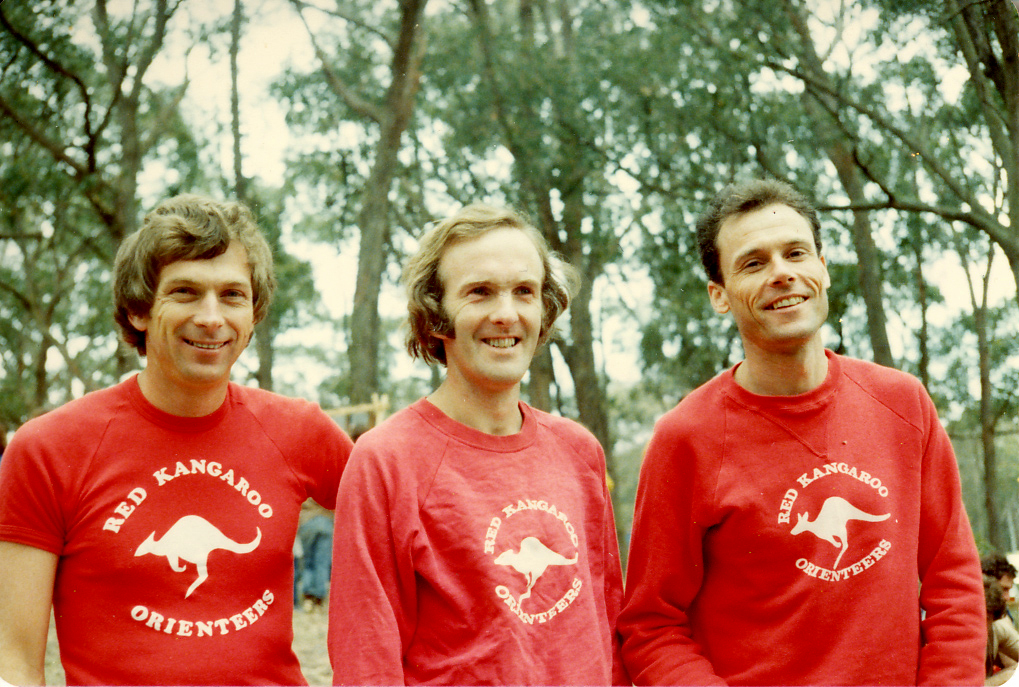
VIC Relays 1979 - M35 Team - Wayne Fitzsimmons, Mike Hubbert, Neil Ryan.